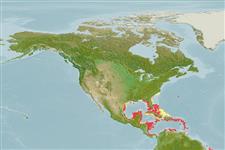Teleostei (teleosts) >
Gobiiformes (Gobies) >
Gobiidae (Gobies) > Gobiinae
Etymology: Lythrypnus: Greek, lythros, -on = blood + Greek, hypnos = sleep (Ref. 45335).
More on author: Bean.
Environment: milieu / climate zone / depth range / distribution range
Ecology
Marine; reef-associated; depth range 4 - 22 m (Ref. 34188). Tropical
Western Central Atlantic: Bermuda.
Size / Weight / Age
Maturity: Lm ? range ? - ? cm
Dorsal spines (total): 7; Dorsal soft rays (total): 8 - 9; Anal spines: 1; Anal soft rays: 7 - 9. Dark bands lacking a pale central area; width of pale bands clearly less than width of dark bands; pattern on cheek usually consisting of 2-4 wide bars radiating from ventral portion of eye, occasionally with portions of bars broken into spots, and the dark bars covering most of cheek, no large unpigmented area anterior to preopercular margin; pectoral-fin base with a single spot, usually covering most of base, the ventral portion of the spot often more intensely pigmented; pectoral-fin rays modally 17 (Ref. 34188).
Most collections taken from the bases of patch reefs or coral encrusted boulders with undercut ledges (Ref. 34188).
Life cycle and mating behavior
Maturities | Reproduction | Spawnings | Egg(s) | Fecundities | Larvae
Greenfield, D.W., 1988. A review of the Lythrypnus mowbrayi complex (Pisces: Gobiidae), wih description of a new species. Copeia 1988(2):460-470. (Ref. 34188)
IUCN Red List Status (Ref. 130435)
Threat to humans
Harmless
Human uses
Tools
Special reports
Download XML
Internet sources
Estimates based on models
Preferred temperature (Ref.
123201): 24.3 - 28.3, mean 27.1 °C (based on 419 cells).
Phylogenetic diversity index (Ref.
82804): PD
50 = 0.5000 [Uniqueness, from 0.5 = low to 2.0 = high].
Bayesian length-weight: a=0.01023 (0.00477 - 0.02194), b=3.02 (2.84 - 3.20), in cm total length, based on LWR estimates for this (Sub)family-body shape (Ref.
93245).
Trophic level (Ref.
69278): 3.2 ±0.4 se; based on size and trophs of closest relatives
Resilience (Ref.
120179): High, minimum population doubling time less than 15 months (Preliminary K or Fecundity.).
Fishing Vulnerability (Ref.
59153): Low vulnerability (10 of 100).
